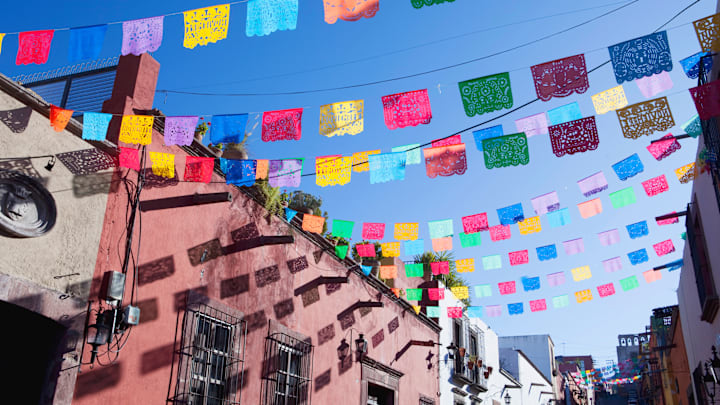For more than 30 years, Americans have celebrated Hispanic Heritage Month from September 15 through October 15 each year—though the country has officially recognized the importance of the Hispanic community’s many contributions to the cultural fabric of America going all the way back to the late 1960s. Here are some facts about how this annual celebration came to be, and how you can take part.
- A celebration of Hispanic heritage was first formally recognized in 1968.
- Hispanic Heritage Month was introduced by California congressman George E. Brown.
- It was originally founded as Hispanic Heritage Week.
- Hispanic Heritage Month begins on September 15—a date that holds an important meaning.
- Hispanic Heritage Month takes place over two months.
- Many of the country’s most important cultural institutions and agencies, including the National Park Service, celebrate Hispanic Heritage Month.
- The Law Library of Congress has an entire website dedicated to Hispanic Heritage Month.
A celebration of Hispanic heritage was first formally recognized in 1968.

The civil rights movement of the 1960s led to increased awareness of underrepresented groups in America, and in June 1968, the United States government began considering how to best formally recognize the contributions of the Hispanic community to America’s history and culture.
On September 17, 1968, Congress passed Public Law 90-48, which allowed President Lyndon B. Johnson to make a presidential proclamation to formally honor Hispanic heritage by marking September 15 and September 16 as the beginning of what was then known as National Hispanic Heritage Week.
Hispanic Heritage Month was introduced by California congressman George E. Brown.
Rep. George E. Brown of California was the person who originally introduced the idea of paying tribute to Hispanic heritage in June 1968. Brown represented East Los Angeles and a portion of the San Gabriel Valley, areas of the state with large Hispanic populations. Brown saw an opportunity to celebrate the culture and recognize its contributions to the United States.
It was originally founded as Hispanic Heritage Week.

While Johnson’s proclamation was a victory for the Hispanic community in terms of creating an annual celebration, initially it was just a single week, not a whole month, that was carved out for these events. Nearly 20 years later, in 1987, Esteban Torres—who represented California's 34th congressional district between 1983 and 1999—introduced H.R. 3182, a bill seeking to expand the festivities from one week to one month. Torres explained that he and his supporters “want the public to know that we share a legacy with the rest of the country, a legacy that includes artists, writers, Olympic champions, and leaders in business, government, cinema, and science.”
Though Torres was unsuccessful in getting his own bill passed, its main purpose and sentiments were shared by Senator Paul Simon of Illinois, who submitted his own bill that would amend the original Public Law 90–468 to account for an extended celebration. Simon had more luck with his bill, which was signed into law by President Ronald Reagan on August 17, 1988.
Hispanic Heritage Month begins on September 15—a date that holds an important meaning.

In the early 19th century, rebellions broke out across Central America as more and more citizens openly opposed Spain’s centuries-old sovereignty over the region. Fortunately, it didn’t lead to an all-out war: Instead, respected leaders and other community representatives from Costa Rica, El Salvador, Guatemala, Honduras, and Nicaragua convened in Guatemala City in 1821 to devise a plan. On September 15, they formally declared freedom from Spain in a document called the Act of Independence. Those five countries now celebrate September 15 as Independence Day.
Hispanic Heritage Month takes place over two months.
Hispanic Heritage Month is unique in that it occurs in two different calendar months. It begins every year on September 15 and extends through October 15. Beyond the five countries that celebrate Independence Day on September 15, Mexico’s Independence Day is on September 16, and Chile’s falls on September 18. By lasting 30 days, the month encompasses these holidays as well as the Mexican celebration of Dia de la Raza on October 12.
Many of the country’s most important cultural institutions and agencies, including the National Park Service, celebrate Hispanic Heritage Month.
If you’re looking for ways to celebrate Hispanic Heritage Month, you’re in luck. A wide range of cultural institutions host a variety of activities and events in honor of the occasion. You can participate in educational webinars held by the National Archives, attend events at the Smithsonian’s museums, and much more. The National Park Service shares ideas for honoring Hispanic Heritage Month in the outdoors and has a rich archive of stories about people and the places they influence.
The Law Library of Congress has an entire website dedicated to Hispanic Heritage Month.
If you’re interested in the political history of how Hispanic Heritage Month came to be, and how it has changed since its initial founding in 1968, the Law Library of Congress hosts a website that maintains copies of the various laws, proclamations, and other legal documents related to this annual celebration.
Discover More Fun Facts for Hispanic Heritage Month:
A version of this story ran in 2020; it has been updated for 2024.
